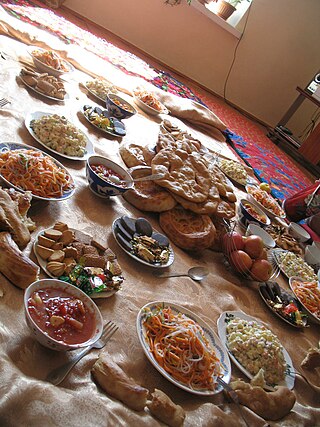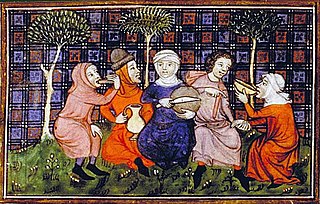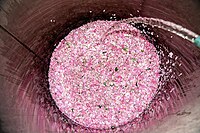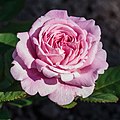
A rose is either a woody perennial flowering plant of the genus Rosa, in the family Rosaceae, or the flower it bears. There are over three hundred species and tens of thousands of cultivars. They form a group of plants that can be erect shrubs, climbing, or trailing, with stems that are often armed with sharp prickles. Their flowers vary in size and shape and are usually large and showy, in colours ranging from white through yellows and reds. Most species are native to Asia, with smaller numbers native to Europe, North America, and northwestern Africa. Species, cultivars and hybrids are all widely grown for their beauty and often are fragrant. Roses have acquired cultural significance in many societies. Rose plants range in size from compact, miniature roses, to climbers that can reach seven meters in height. Different species hybridize easily, and this has been used in the development of the wide range of garden roses.

Blancmange is a sweet dessert popular throughout Europe commonly made with milk or cream and sugar thickened with rice flour, gelatin, corn starch, or Irish moss, and often flavoured with almonds.

A cookbook or cookery book is a kitchen reference containing recipes.

Gulab jamun is a sweet confectionary or dessert, originating in the Indian subcontinent and a type of mithai popular in India, Pakistan, Nepal, the Maldives, and Bangladesh, as well as Myanmar. It is also common in nations with substantial populations of people with South Asian heritage, such as Mauritius, Fiji, Gulf states, the Malay Peninsula, Great Britain, South Africa, and the Caribbean countries of Jamaica, Trinidad and Tobago, Guyana, and Suriname.

Steam distillation is a separation process that consists of distilling water together with other volatile and non-volatile components. The steam from the boiling water carries the vapor of the volatiles to a condenser; both are cooled and return to the liquid or solid state, while the non-volatile residues remain behind in the boiling container.

Nigella sativa is an annual flowering plant in the family Ranunculaceae, native to eastern Europe and western Asia, but naturalized over a much wider area, including parts of Europe, northern Africa and east to Myanmar. It is used as a spice in many cuisines.

Iranian cuisine is the culinary traditions of Iran. Due to the historically common usage of the term "Persia" to refer to Iran in the Western world, it is alternatively known as Persian cuisine, despite Persians being only one of a multitude of Iranian ethnic groups who have contributed to Iran's culinary traditions.

Rose oil is the essential oil extracted from the petals of various types of rose. Rose ottos are extracted through steam distillation, while rose absolutes are obtained through solvent extraction, the absolute being used more commonly in perfumery. The production technique originated in Greater Iran. Even with their high price and the advent of organic synthesis, rose oils are still perhaps the most widely used essential oil in perfumery.

Iraqi cuisine is a Middle Eastern cuisine that has its origins in the ancient Near East culture of the fertile crescent. Tablets found in ancient ruins in Iraq show recipes prepared in the temples during religious festivals—the first cookbooks in the world. Ancient Mesopotamia was home to a sophisticated and highly advanced civilization, in all fields of knowledge, including the culinary arts.

Kashk, qurut, chortan, or aaruul and khuruud is a range of dairy products popular in Middle Eastern cuisine, Caucasian cuisine, and Central Asian cuisine. Kashk is made from strained yogurt, drained buttermilk or drained sour milk by shaping it and letting it dry. It can be made in a variety of forms, like rolled into balls, sliced into strips, and formed into chunks.

Central Asian cuisine has been influenced by Persian, Indian, Arab, Turkish, Chinese, Mongol, African and Russian cultures, as well as the culinary traditions of other varied nomadic and sedentary civilizations. Contributing to the culinary diversity were the migrations of Uyghur, Slav, Korean, Tatar, Dungan and German people to the region.

Rosa × damascena, more commonly known as the Damask rose, or sometimes as the Iranian Rose, Bulgarian rose, Arab rose, Ispahan rose and Castile rose, is a rose hybrid, derived from Rosa gallica and Rosa moschata. DNA analysis has shown that a third species, Rosa fedtschenkoana, has made some genetic contributions to the Damask rose.

Medieval cuisine includes foods, eating habits, and cooking methods of various European cultures during the Middle Ages, which lasted from the 5th to the 15th century. During this period, diets and cooking changed less than they did in the early modern period that followed, when those changes helped lay the foundations for modern European cuisines.

An entremet or entremets in French cuisine historically referred to small dishes served between courses but in modern times more commonly refers to a type of dessert.
More or less distinct areas in medieval Europe where certain foodstuffs dominated can be discerned. In the British Isles, northern France, the Low Countries, the northern German-speaking areas, Scandinavia and the Baltic the climate was generally too harsh for the cultivation of grapes and olives. In the south, wine was the common drink for both rich and poor alike while beer was the commoner's drink in the north and wine an expensive import. Citrus fruits and pomegranates were common around the Mediterranean. Dried figs and dates occurred quite frequently in the north, but were used rather sparingly in cooking.

Chashni or Chaashni means a condiment and is a spice, sauce, or preparation that is added to food to impart a specific taste, to enhance the flavor, or to complement the dish. Some chaashnies are used during cooking to add flavor or texture: saffron, barbecue sauce, teriyaki sauce, soy sauce, and pomegranate juice are examples. Chaashnies are sometimes added prior to serving and is used to taste by the dish, for example, in a sandwich made with ketchup, mustard, mayonnaise, Sriracha, or hot sauce. One of the most important secrets of famous chefs around the world is the use of delicious chaashnies for various dishes. It goes without saying that choosing a good chaashni will make the food or salad tastier and more delicious.

Mizrahi Jewish cuisine is an assortment of cooking traditions that developed among the Jews of the Middle East, North Africa, Asia, and Arab countries. Mizrahi Jews have also been known as Oriental Jews.

Muhallebi is a milk pudding commonly made with rice, sugar, milk and either rice flour, starch or semolina, popular as a dessert in the Turkey and Middle East. While the dessert is called Muhallebi in Turkey and Iraq, the Egyptian variant is called mahalabia, the levantine variant is called mahalabiyeh.
Powder-forte was a medieval spice mix similar to poudre douce, but often incorporating more pungent flavors like pepper. Spice mixes like powder-forte were a common ingredient in the recorded recipes of medieval cuisine, often used in combination with foods that are not heavily spiced in modern preparations. One example is a recipe for cherries, washed clean with wine and filtered through a cloth, then heated with "white grease" and rice flour in a pot until stiff. To this cherry mixture, the cook would add honey, vinegar, egg yolk and "strong powder" - in this case, a mix of cinnamon and cypress root. Along with poudre douce, poudre fine and poudre lombard it is one of four medieval spice mixtures found throughout an assortment of medieval cookery manuscripts.

























